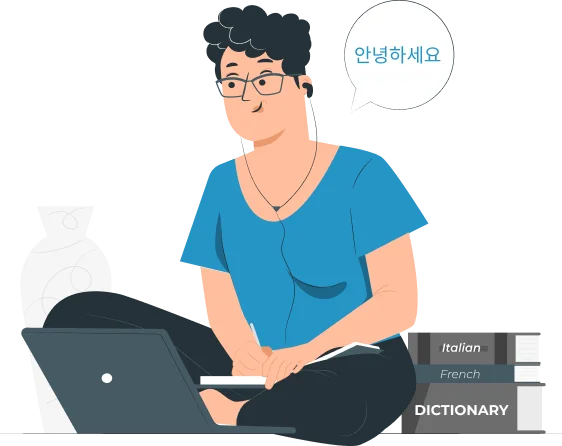Our medical translation specialists are well versed in medical terminology, including pharmaceutical, treatment protocols, and diagnostic procedures. Their domain expertise, combined with their understanding of cultural sensitivities, guarantees that our Korean medical translation services are precise and culturally appropriate for Korean patients.
Professional Korean Translation Services
Get your quote

CCJK Is Your Trusted Korean Translation Company
With more than 2 decades of experience, CCJK stands out as your reliable Korean translation provider. We have helped the world’s leading organizations localized their businesses for better reach in foreign markets. Our team of native Korean linguists, with expertise in diverse industries, ensures culture appropriate brand messaging that resonates with your target audience. We offer certified Korean translation services in fast turnaround times to achieve 100% client satisfaction from initial project quote to final delivery.
Our clients
World’s top organizations rely on CCJK
Convey Your Brand Voice Authentically to Korean Audience
Our team understands the cultural intricacies, humor, and emotions that breathe life into language. We make your brand voice resonate with the target market with our premium Korean marketing translation services. Our team of professional linguists meticulously adapts your message to the Korean context and makes sure it strikes the right tone. It will establish a brand voice that feels authentic and culturally relevant so that you can penetrate the Korean market seamlessly. Let us help you build trust and form genuine connections with your Korean customers.

Get A Free Korean Translation Consultation

Accurate & Fluent Translations from Native Korean Translators
Our Korean translators, with years of experience, deliver translations that are both accurate and naturally fluent. They have a deep understanding of Korean grammar, terminology, and cultural references that allow them to translate with precision. It confirms your message is not only grammatically correct but also conveys the intended meaning. From website transcreations and technical business documents to Korean subtitling services, our expert linguists translate all types of content.
Tailored Korean Translation Solutions for Every Industry
From technology and finance to healthcare and marketing, our subject-matter experts deliver specialized translations that are on spot. We speak the language of your business and ensure impactful communication in every sector.
The legal expertise of our translators allows them to meticulously translate contracts, patents, litigation documents, and other legal materials, considering Korean legal requirements. Whether you’re entering the Korean market for the first time or managing ongoing legal matters, our team guarantees clear Korean legal translation services.
We help you seamlessly localize your websites for the Korean market. Our team of translators have the expertise and they use best practices to deliver user-centric Korean website translation services. They translate the website’s instructions, menus, error messages, and marketing materials so that Korean users can interact with your websites intuitively.
Our game translators translate in-game text, menus, dialogue, and marketing content, preserving the original intent. They understand the nuances of Korean culture and language, so the translated jokes land, references resonate, and the overall narrative remains captivating for Korean audiences.
Expand Your Reach in Korean Markets
Hire the Best Onsite and Virtual Korean Interpreters
The success of your cross-cultural interactions depends on clear and nuanced communication. At CCJK, we provide access to a network of top-tier Korean interpreters, ready to bridge the language gap in both onsite and virtual settings. Our interpreters have extensive experience in diverse fields to ensure your message is delivered with precision. They expertly navigate technical details, subtle conversational cues, and cultural expressions that result in smooth communication. Get premium Korean interpreting services at competitive rates.

CCJK Is Your Full Suite Korean Translation Agency with Proven Track Record
We’re a reliable Korean translation company with a history of meeting our clients’ expectations, building lasting partnerships, and helping businesses thrive in the Korean market. Reach your full potential in Korea with best-in-class English to Korean translation services.

Native Translators
Every translator is carefully selected based on their expertise and understanding of Korean language nuances and cultural sensitivities. Forget robotic, literal translations; with CCJK, you get natural and culturally-attuned Korean document translation services.

Flexible Solutions
CCJK offers a comprehensive range of Korean language translation services, from software and website localization to Korean technical translation services. We also cater to various turnaround times so that your project is completed efficiently without compromising quality.

On-Time Delivery
Our streamlined workflow and efficient project management system ensure your translations are delivered on time. It allows you to focus on your core business activities when your language needs are taken care of by experts.

Satisfied Customers
We have built long-standing relationships with clients across diverse industries. Their positive testimonials and repeat business are a testament to the quality of our English to Korean and Korean to English translation services.
Communicate Fluently with Korean Audience
Regional Dialects of the Korean Language
While standard Korean dominates communication, understanding regional dialects of the Korean language offers a deeper appreciation for Korean culture and the nuances of spoken communication. Here at CCJK, we have native Korean translators covering all the regional dialects. The following table demonstrates the major Korean dialects spoken in different regions across the country.
| Dialects | Regions | Key Characteristics |
|---|---|---|
Gyeonggi (Seoul) |
Seoul Metropolitan Area, parts of Gyeonggi Province |
Basis for Standard Korean, vowel and consonant variations |
Gyeongsang |
Gyeongsangbuk-do and Gyeongsangnam-do Provinces |
Shortened sentences, unique vocabulary, vowel and consonant variations |
Chungcheong |
Chungcheongbuk-do and Chungcheongnam-do Provinces |
Closer to Standard Korean, some vowel and consonant variations |
Gangwon |
Gangwon Province |
Retention of some archaic features, pronunciation differences |
Jeolla |
Jeollabuk-do and Jeollanam-do Provinces |
Strongest dialect differences, unique vocabulary, pronunciation variations |
Jeju |
Jeju Island |
Considered a separate language by some linguists, significant vocabulary and grammar differences |
Korean Case Studies
Meet Our Team of Professional Korean Linguists

Sun-Hi Kim
Sun-Hi is a certified translator with over 15 years of experience. A native Korean speaker raised in Canada, she excels in translating business documents, marketing materials, and websites. She is also passionate about Korean literature and enjoys translating contemporary Korean novels.

Hye-Jin Lee
Hye-Jin is a young and energetic Korean translator with a knack for creative content. With a background in journalism and film studies, she thrives on translating scripts, subtitles, video games, and marketing campaigns. Hye-Jin stays up-to-date on current trends and slang, making her translations sound natural and engaging.

Dr. Ji-Soo Choi
Dr. Choi is a highly qualified translator with a Ph.D. in Korean Literature. She specializes in academic texts, historical documents, and literary works. Dr. Choi is known for her deep understanding of Korean culture and her ability to produce nuanced and eloquent translations.

David Kang
David is a Korean-American translator who bridges the gap between the two cultures. He is comfortable translating across various fields, including business, legal, medical, and technical documents. David’s fluency in both languages and understanding of cultural nuances make him a valuable asset to any project.
Let’s Hear it From Our Clients
We were launching a new mobile game in Korea, and needed the in-game text and marketing materials translated flawlessly. CCJK did a great job. Their translation captured the humor and personality of the game perfectly, and the marketing materials resonated well with the Korean audience.
Stephen C. BrownI needed my business website translated into Korean to reach a wider audience. CCJK’s translators did an amazing job. The translation was accurate, natural-sounding, and captured the tone of my brand perfectly. I've already seen an increase in traffic from Korea!
Bernd HerrmannAs a patent attorney, I needed someone to translate a complex intellectual property contract with precision. CCJK assigned a skilled translator with a legal background. He ensured every nuance of the contract was conveyed accurately.
Seth RosmanWorking with CCJK was a breeze. As a Korean-American business owner, I needed someone who understood both cultures. Their team translated our marketing materials and presentations seamlessly, and we are very satisfied with their service.
Roxane GillespieOur software company released a new product with a Korean language option. Team Ccjk ensured the user manuals and software interface were translated with clarity and accuracy. They even suggested some improvements to the user interface for the Korean market.
Orson QuennevilleFAQs
frequently asked questions

Do you provide revisions for the translated content?
We prioritize content quality and clients’ satisfaction above anything else. Projects can sometimes require adjustments based on client feedback. Our clients can contact us anytime for translation revisions to meet their goals.
Can you provide references or case studies for similar translation projects?
We surely can do that. Client satisfaction and comfort are what we prioritize the most. There are case studies available for your reference and a better understanding to make it clear how we execute our translation projects.
What security measures do you take to protect my confidential documents during Korean translation?
We at CCJK are aware of the ethical practices that come with the translation process. We have implemented data protection rights and also made our translators sign non-disclosure agreements (NDA) to protect the content and maintain the confidentiality of Korean documents for our clients.
How do you ensure language consistency in a large-scale translation project?
In order to effectively manage large-scale projects, we develop a comprehensive style guide with terminology and determine the right tone for the target audience. It reduces the chances of inconsistency and variations throughout the translation project. We also use a centralized TMS to manage people and resources, which confirms that everyone refers to the same resources and project glossaries.
Can I discuss my translation project with someone by phone?
Yes, you can discuss your Korean translation project related queries with our sales team and project managers on the phone.
